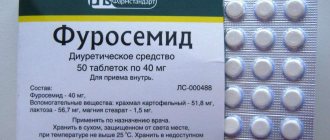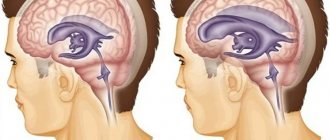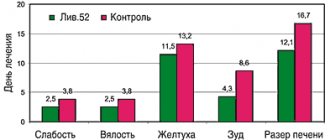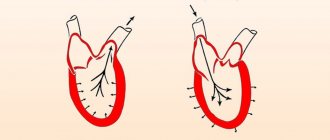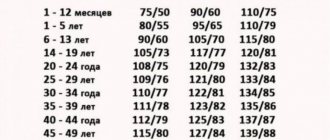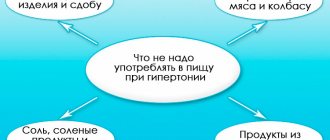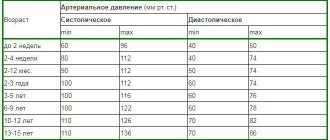Intracranial pressure in a child
The brain is washed inside and outside by cerebrospinal fluid, or cerebrospinal fluid. It serves as protection for the brain, washes it, nourishes and protects it from mechanical stress, helps maintain constant intracranial pressure, and also supports metabolic processes between the blood and the brain. This fluid constantly circulates inside the skull, in the ventricles of the brain and in other spaces of the brain and spinal cord.
Cerebrospinal fluid is formed in certain areas of the brain, flows out from there, is distributed to other areas, and is then absorbed back.
There is a certain balance between the release and absorption of this fluid. If more fluid is released than can be absorbed back, or less is absorbed than is released, or somewhere along the way there are obstacles to the outflow of fluid, then it accumulates in a certain place, thereby causing intracranial pressure. Since the head is a closed cavity, the brain is inside the skull and has nowhere to go, the accumulated fluid begins to put pressure on the brain, squeezing it, and it, for its part, begins to resist and, thereby, causes an increase in intracranial pressure. In this case, the child may constantly or occasionally complain of headaches.
Increased intracranial pressure in infants is not a rare case. Such a child grows up with increased intracranial pressure from an early age, but does not complain of a headache, because he no longer feels it, since he grew up with it. The brain itself does not have pain receptors, but they are present in the meninges. Prolonged intracranial pressure leads to stretching of the meninges and headaches occur. If a child has suffered intrauterine hypoxia or infection, neuroinfection, trauma at birth, or there are any congenital defects, prematurity, then increased intracranial pressure is possible from the moment of birth.
Such children, as a rule, do not complain of headaches, because this is their normal condition. But at the same time, the child may be overly excitable or cannot maintain concentration for a long time, or the child is slowly developing some individual mental functions: speech, walking, writing, memory, logic, counting, phonemic hearing. Therefore, for almost any dysfunction of the child’s nervous system, it is recommended to check the nervous system for the presence of increased intracranial pressure. It often happens that a child allegedly has psychological problems, but in fact, the child is simply very uncomfortable due to problems with high intracranial pressure.
If cerebrospinal fluid presses on the brain for a long time, the volume of the brain under pressure decreases, and the volume of the fluid cavities of the brain increases, and this is called hydrocephalus. Partial replacement of brain matter with fluid occurs. In severe cases, disruption of the formation of nervous system functions in newborns, even cerebral palsy, can occur. Severe cases of hydrocephalus are operated on, a shunt is performed and excess fluid is drained through the shunt. But, in most cases, with the help of neurological and osteopathic treatment, it is possible to cope with such diseases without surgery.
There are 6 types of headaches:
- Muscle tension
- Vascular
- Neuralgic
- Liquorodynamic
- Functional or psychalgia
- Mixed
Here is an interesting plate based on statistical data from outpatient visits to a pediatric neurologist at our clinic.
Please note that complaints of headaches appear in children in preschool age, with a subsequent increase.
| Age/ Nosology | 0-1 year | 1-3 years | 4-7 years | 8-10 years | 11-14 years old | 15-17 years old |
| Headaches, unspecified | 7% | 9% | 16% | 18% | ||
| Tension type headaches | 3% | 12% | 18% | 24% | ||
| Vascular headache | 0.3% | 0.8% | 2% | 10% | 18% | |
| Migraine | 1% | 1% | 1% | 1% | ||
| Functional, including against the background of cerebrovascular disease | 2% | 4% | 6% | 9% |
Tension type headaches
(psycho-emotional or muscle pain) occur when the child’s psycho-emotional load does not match his capabilities (emotional-volitional or cognitive), which in turn increases the tone of the “emotional” muscles that are attached to the periosteum of the skull. This muscle pain is considered a headache. Now it becomes clear why this type of headache is characteristic of the age at which preparation for school begins, and increases exponentially by the time of passing the Unified State Exam.
Vascular headache
This is pain in response to stretching or inflammation of the vascular wall. There can be many reasons, from vascular abnormalities to banal vascular dystonia. Migraine is also a type of vascular headache, has characteristic clinical manifestations, and its cause is aseptic inflammation of the vascular wall.
Neuralgic headache
occurs when there is pressure on the nerve trunk, its branch or node, and after compression there is ischemia and pain. The reason for this may be post-traumatic or inflammatory swelling along the nerve, as well as any space-occupying formation. Neuralgic headache can also be of central origin, as a result of dysfunction of the nociceptive and antinociceptive systems of the brain.
In the occurrence of liquorodynamic headache
the main role is played by increased intracranial pressure. Intracranial pressure may increase with the appearance of additional formations, both liquid and solid, in the cranial cavity, which in turn compresses and/or displaces the meninges, blood vessels and nerves, causing pain. This may be a tumor, inflammation of the meninges of the brain (meningitis). Intracranial hypertension can also occur as a result of the appearance of any neoplasm that obstructs the outflow of cerebrospinal fluid from the cranial cavity.
Functional headache
most often has a psychogenic mechanism.
Mixed form, has mixed origin.
We have analyzed six types of headaches, which, in turn, have different causes.
To figure out what exactly is causing your child’s headaches, you need to contact a pediatric neurologist, who, after a neurological examination, will decide whether you need consultation with a related specialist and may prescribe additional examination methods.
In the children's building of the clinic
You will be able to get advice from experienced specialists, as well as conduct all the necessary examinations to identify the causes of headaches in your child.
Information prepared for you by:
Razina Elena Evgenievna – pediatric neurologist, epileptologist, functional diagnostics doctor, leading specialist of the clinic. Conducts a reception in the Children's building on Usachev.
Diagnostic methods
Unfortunately, it is currently impossible to accurately measure intracranial pressure - there is no special device such as a tonometer that will show specific indicators. Therefore, when diagnosing pathology in a child, doctors use other laboratory and instrumental techniques, and also focus on the symptoms characteristic of the disease. Here is a list of diagnostic procedures that do not measure cerebrospinal fluid pressure in the brain and spinal cord, but record changes characteristic of hypertensive syndrome:
- Blood tests. They make it possible to detect the presence in the body of a pathogenic pathogen that penetrates the blood-brain barrier and contributes to infection of the meninges.
- Examination of cerebrospinal fluid (puncture). It is prescribed by a neurologist for important clinical indications and allows you to check whether there are hidden neuroinfections in the child’s body or whether there has been a spinal cord or brain injury.
- NSG (neurosonography). It is carried out to record pathological changes in the structures of the brain.
- Ultrasound of the head and blood vessels. Clearly describes defects in the structure of capillaries and determines the level of intracranial pressure.
- CT and MRI diagnostic methods are indicated for children with signs of birth injuries; they allow one to assess the influence of these factors on the condition of blood vessels and cerebral ventricles.
Magnetic resonance imaging for intracranial pressure is a very effective diagnostic method
The child is also advised to consult an ophthalmologist for an extensive fundus examination. The presence of hypertensive syndrome can be indirectly confirmed by recording the spasm of the capillaries located at the bottom of the eye.
general information
It happens that a completely healthy newborn baby begins to cry for no apparent reason, refuse to eat, have trouble falling asleep or sleep restlessly at night. Or older children complain of severe headaches , which may be accompanied by bouts of vomiting against the background of a general loss of strength. In such cases, doctors often diagnose increased intracranial pressure (hereinafter referred to as ICP).
What is ICP and what are its symptoms? What could be the causes and consequences of this ailment for a person’s health and well-being? We will answer this and many other questions on the topic in this material. But first, let's look at some general questions that relate to the physiology and structure of the human brain.
Diagnosis of increased intracranial pressure
If your child develops the above symptoms, you need to show your child to a neurologist. The doctor will assess the state of the child’s reflexes, determine the condition of the baby’s large fontanel, the size of the head, and collect an anamnesis.
In addition to a neurologist, the child should be examined by an ophthalmologist to determine the pathology of the fundus (enlarged veins, spasm of arteries in the fundus, swelling of the optic disc - all these are clinical symptoms of increased intracranial pressure).
For young children with an open fontanel, neurosonography is prescribed - ultrasound diagnostics of the brain. Additional studies, such as computed tomography or magnetic resonance imaging, are possible, if necessary.
Characteristic symptoms
In children, signs of intracranial pressure may be nonspecific with small lesions of the cerebral ventricles. They can be confused with other symptoms that manifest many inflammatory pathologies. Therefore, hypertensive syndrome can usually be recognized by its clear clinical symptoms:
- enlargement of the skull in volume - this symptom is typical for newborns and infants with signs of ICP; in severe forms of the pathology, the head increases by several centimeters above normal;
- protrusion of the eyes - this leads to incomplete closure of the eyelids, during sleep the irises of the eyeballs are visible in the baby;
- pulsation manifested in the area of the large fontanelle - upon examination and palpation, it protrudes above the surface of the skull and looks swollen;
- a pronounced venous network on the head - high pressure provokes congestion of the veins, they are clearly visible on the surface of the skin;
- frequent regurgitation is a symptom characteristic of children in the first 2–3 months of life (due to compression of the nerve receptors responsible for the functions of important parts of the body, the baby regurgitates 3–4 times a day);
- deterioration of health - lying on his back, the child becomes capricious, cries, calming down only in his arms. This is explained by the overflow of the veins with blood in a horizontal position and an increase in the level of intracranial pressure;
- sleep disturbances – this symptom becomes pronounced in children aged 2 years and older (up to 6–7 years), the child’s sleep is superficial, he often wakes up and cannot rest for more than 1–2 hours in a row;
- disturbance of psychophysical development - the baby lags behind normal indicators, later begins to sit and crawl, speech functions suffer in comparison with peers.
An older child can already formulate his complaints - he is bothered by regular headaches of a diffuse nature, especially in the evening and at night.
The baby also complains of frequent attacks of nausea, sometimes ending in vomiting - but the condition does not improve, and the gag reflex is not associated with the food eaten the day before. Children of preschool and school age react to hypertensive syndrome with speech development disorders - they confuse words, speak poorly, have a lisp, and often require the help of a speech therapist.
Intellectual functions also suffer - the child has difficulty concentrating on studies, he is unable to solve complex problems. For these reasons, a schoolchild becomes prone to depression; he shows signs of nervousness, is constantly capricious, offended and cries. At the same time, the child’s appetite is impaired, which is why children with severe signs of ICP are often thin and petite.
